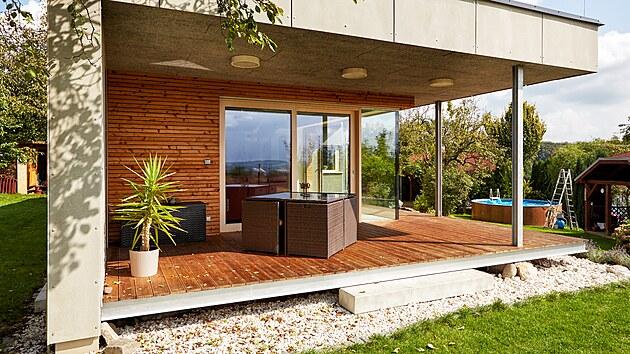
They wanted to live with their parents.They built a house made of cement and wood in the garden
"It was not the fact that we saved something money with the extension," explains Tomáš.”Above all, we wanted to stay in sight of parents with whom we lived in an old house for several years after the birth of children, and then we have a strong link to the place.”
As the children grew, young parents began to perceive their half of the house as spatially insufficient, and at the same time realized that the cost of operating brick housing is unnecessarily burdened and do not provide good user comfort.They therefore decided to rebuild the existing housing unit.
| 8 fotografií |
For her design, the architect's husbands addressed, with regard to the spatial and energy requirements, size and shape of the land and the protection zone of the technical infrastructure, recommended connecting existing housing with a single -store.
Dispozici a tvar dřevěné přístavby určila představa o otevřeném prostoru, o pohybu „malých pokladů”, orientace ke světovým stranám, vazba na výhledy do okolí, terénní konfigurace zahrady, umístění dětského hřiště i poloha hospodářské části.
Tomáš and Jitka had the entire ground floor available in the old house.They wanted to build on it with the fact that in the brick part there will be a resting part where they spend less time and it is not necessary to fully heat here all day.So bedroom with dressing room, two children's rooms, two bathrooms and laundry.

They then moved the social part - kitchen, dining room and study and study to the energy -efficient wooden building.The arrangement of rooms on one floor then supports the cohesive interaction of activities in accordance with the routine of the inhabitants of the house.
Tomáš and Jitka also entrusted the interior design into the hands of the architect.One of the dominant fixtures and decorative elements is the stove with corner glazing specifically designed for low -energy houses.
Their construction even with reduced thermal output helps to achieve high efficiency and thus low operating costs.The central supply of external air into the combustion chamber is an important structural part of the stove that does not affect the hood exhaust or - if they had it - controlled ventilation.
In addition, fire does not take oxygen from the room.Despite these benefits, the stove is not a primary source of heating and are lit..
Pairing
The logical arrangement of the user concept is strengthened by the selection of building materials.The outer sheath in the gray shade of cement -fiber boards is complemented.
Vnitřní „podšívka” pláště domu pokračuje v materialitě kombinací bílé výmalby a smrkové biodesky na straně jemné a betonového ztraceného bednění za krbem spolu s cementotřískovým podhledem stropu na straně hrubé.All together with a suitable choice of fixtures according to the architect's invention creates an impressive interaction of industrially and cozy warm design.
Wooden surfaces next to material cement elements lead to lightening the otherwise heavy building element and ocher color of wood combined with industrial gray bring heat and balance.
Technical parameters:
Další zajímavé dřevostavby najdete v aktuálním čísle magazínu DŘEVO&stavby.Photos: Jakub Sobotka







